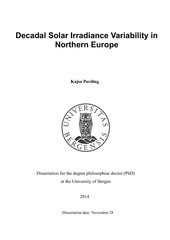| dc.contributor.author | Parding, Kajsa | eng |
| dc.date.accessioned | 2014-12-18T09:09:28Z | |
| dc.date.available | 2014-12-18T09:09:28Z | |
| dc.date.issued | 2014-11-28 | eng |
| dc.identifier.isbn | 978-82-308-2789-5 | en_US |
| dc.identifier.uri | https://hdl.handle.net/1956/8974 | |
| dc.description.abstract | Shortwave (SW) radiation from the Sun is the external energy source on Earth and the fundamental input of energy into the climate system. Variations of the SW radiation and its transfer through the atmosphere can have important consequences for the living conditions on our planet. Previous studies have reported decadal to multi-decadal variations of SW irradiance at the surface of the Earth of magnitudes comparable to those of greenhouse gas forcing. The observed SW trends are known as global dimming (decreasing SW irradiance) and brightening (increasing SW irradiance). Varying amounts of atmospheric aerosols, humidity, and clouds, and interactions among these factors are likely candidates to explain the observed SW irradiance variability. Understanding the causes of SW irradiance variations is important because it is informative of the past and future of dimming and brightening: SW irradiance variations that are due to anthropogenic activity will continue to depend on the action of humans; SW irradiance variability that is associated with natural climate variability is not within our control, but can be predicted provided that the variations of the climate system are predictable and well understood. The aim of this thesis is to investigate the observed decadal variability of SW irradiance in northern Europe. The thesis consists of four papers that all concern aspects of atmospheric transfer of SW radiation through the atmosphere including the relationship between clouds and SW irradiance. Papers I–III consider the role of clouds and large scale atmospheric circulation plays for dimming and brightening in northern Europe. To this end, we develop empirical-statistical models of solar and cloud variables based on the frequency distribution of the Grosswetterlagen (GWL), a classification of European large scale metorological weather patterns. The GWL models are used to evaluate how the frequencies of cyclonic and anti-cyclonic weather patterns influence the SW radiative climate at different sites. In Bergen, Norway, a decrease of SW irradiance and concurrent increase in cloudiness is observed from the 1960s to around 1990. This cloud-induced dimming is traced to an increasing frequency of cyclones and decreasing occurrence of blocking anti-cyclonic systems. The observed large scale circulation changes influence the radiative climate in other parts of northern Europe too, but results presented in paper III indicate that other more local factors such as varying aerosol emissions may have a more dominant influence at some sites (Stockholm, Sodankyla). In the last two decades, a significant increase in SW irradiance is found at many sites in northern Europe in spring (March–April). Our model indicates that this brightening cannot be explained by observed large-scale circulation shifts and we conclude that decreasing aerosol emissions since the late 1980s may be a likely explanation. Paper IV deals with the absorption of SW radiation by clouds. It connects to the issue of dimming and brightening because the SW absorptivity of clouds influence the SW signal that satellites retrieve. Hence investigating dimming and brightening via satellite data will depend on the correct estimate of cloud absorption. This thesis provides an introduction to the factors that influence SW irradiance and their potential contribution to the observed dimming and brightening. We conclude, based on results presented in the four papers, that the relative importance of the large scale atmospheric circulation, clouds, and other factors that influence SW irradiance may vary from site to site and period to period. Therefore, a regional and local scale may be preferable to a global or continental perspective when studying the causes and effects of dimming and brightening. | en_US |
| dc.language.iso | eng | eng |
| dc.publisher | The University of Bergen | en_US |
| dc.relation.haspart | Paper I: Parding, K., Olseth, J. A., Liepert, B. G., and Dagestad, K.-F. (2014). Decadal variability of clouds, solar radiation and temperature at a high-latitude coastal site in Norway. Full text not available in BORA. | en_US |
| dc.relation.haspart | Paper II: Parding K., Olseth, J. A., Liepert, B. G., and Dagestad, K.-F. (2014). Influence of atmospheric circulation patterns of local cloud and solar variability in Bergen, Norway. Full text not available in BORA. | en_US |
| dc.relation.haspart | Parding, K., Liepert, B. G., Hinkelman, L. M., Ackerman, T. P., Dagestad, K.- F., and Olseth, J. A. (2014). Influence of synoptic weather patterns on solar irradiance variability in northern Europe. Full text not available in BORA. | en_US |
| dc.relation.haspart | Paper IV: Parding, K, Hinkelman, L. M., Ackerman, T. P., and McFarlane, S. A. (2011). Shortwave absorptance in a tropical cloudy atmosphere: Reconciling calculations and observations. Journal of Geophysical Research 116, D19202. The article is available at: <a href="http://hdl.handle.net/1956/8973" target="blank">http://hdl.handle.net/1956/8973</a>. | en_US |
| dc.title | Decadal solar irradiance variability in northern Europe | en_US |
| dc.type | Doctoral thesis | |
| dc.rights.holder | Copyright the author. All rights reserved | en_US |
